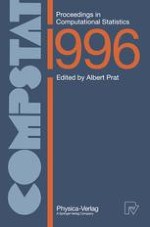1996 | OriginalPaper | Buchkapitel
Do Parametric Yield Estimates Beat Monte Carlo?
verfasst von : Dee Denteneer, Ludolf Meester
Erschienen in: COMPSTAT
Verlag: Physica-Verlag HD
Enthalten in: Professional Book Archive
Aktivieren Sie unsere intelligente Suche, um passende Fachinhalte oder Patente zu finden.
Wählen Sie Textabschnitte aus um mit Künstlicher Intelligenz passenden Patente zu finden. powered by
Markieren Sie Textabschnitte, um KI-gestützt weitere passende Inhalte zu finden. powered by
Simulation models are playing an increasing role in industry and often form the basis for product design and optimization. They are used among other things for yield computation, the computation of the proportion of products that satisfy imposed quality requirements, given the natural variations inherent in the manufacturing process. In mathematical terms: a function q(x1,…, x p ) is given which determines product quality q as a function of process parameters x1,…,x p . Products with quality l < q < u are acceptable, others are scrapped. Furthermore, the random variation in the process parameters (x1,…, x p ) is described by a continuous distribution F. Then the yield y is given by $$\matrix{ y \hfill & = \hfill & {\int_{l < q\left( {{x_1},...,{x_p}} \right) < u} {dF\left( {{x_1},...,{x_p}} \right)} } \hfill \cr {} \hfill & = \hfill & {\int_{{{\left[ { - \infty ,\infty } \right]}^p}} {\phi \left( {l < q\left( {{x_1},...,{x_p}} \right) < u} \right)dF\left( {{x_1},...,{x_p}} \right).} } \hfill \cr } $$ So we are concerned with numerical integration of an indicator function, ⌽, multiplied by a density in p-dimensional space, say p = 5 to 100. This is in contrast with current numerical integration work aiming at the integration of a smooth integrand to compute the posterior distribution in a Bayesian setting; see, for example, Flournoy and Tsutakawa, 1991. Moreover, the integration of a discontinuous function ⌽ invalidates error bounds in quasi-Monte Carlo integration (see, for example, Niederreiter, 1992), as ⌽ is generally of infinite variation.
